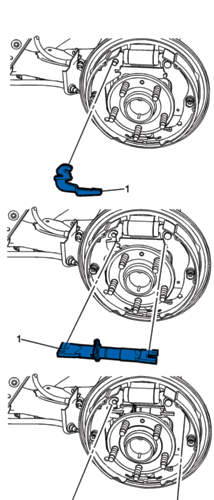The Chevy Sonic is GM’s compact car that took over where the Aveo left off. Redesigned in 2011, the Sonic uses front discs and rear drums and comes with ABS and stability control standard.
The system has had few complaints or TSBs issued. Servicing the brakes is straightforward and does not require any special tools except a scan tool to bleed the ABS modulator.
 Front Brakes
Front Brakes
The front brakes on the Sonic use single piston calipers. The only hardware items are abutment clips that should be replaced with the brake pads.
The caliper brackets have a torque specification of 74 ft.-lbs; the caliper guide pin bolts have a torque spec of 21 ft.-lbs.
The front guide pins have been an issue. On some 2011 and 2012 models, the original pins and booths were too small for the holes in the caliper bracket. This can cause a rattle or clunk noise to come from the front end. Updated parts are available, consult PI PIC5591 in the service information for the full details. Most aftermarket parts have been updated.
Rear Brakes
The Sonic uses rear drums. After shoe replacement, the shoes must be adjusted to match the diameter of the drum. The rear brakes should have 0.4 mm – 0.9 mm of clearance between the shoes and drum.
The rear drums are self adjusting, but the adjustment of the parking brake lever is not.
To adjust the parking brake, with the parking brake lever in the released position, loosen the adjusting nut enough to completely relieve tension on the front cable. Each shoe should have between 0.4 mm – 0.9 mm of clearance. The lever should have full engagement after three clicks.
Some Sonic drivers may comment on a loose parking brake lever/handle. This may be caused by the adjusting nut being out of adjustment. The condition will not affect the ability to engage the parking brake.
To fix, readjust the parking brake cable-adjusting nut. First, measure the distance from the end of the parking brake cable to the front of the adjusting nut as shown in the photo below.
If the distance is less than 30 mm (1.18 in), tighten the park cable adjusting nut until the threaded portion of the front parking brake cable extends beyond the adjusting nut approximately 30 mm (1.18 in).
Courtesy Brake & Front End.














